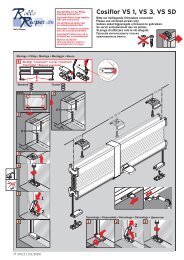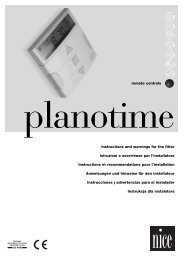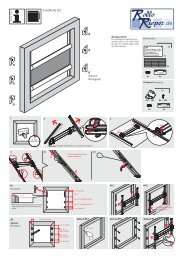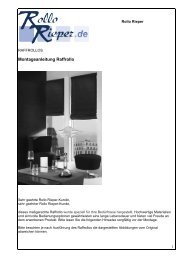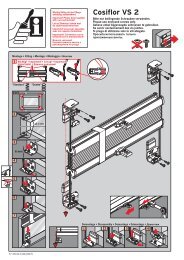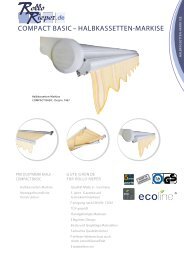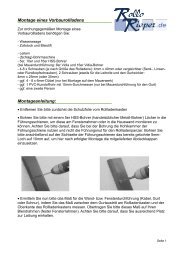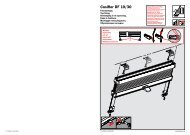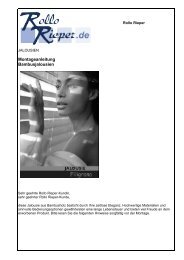Neomat A 89.028 NS rev1 - Rollo Rieper
Neomat A 89.028 NS rev1 - Rollo Rieper
Neomat A 89.028 NS rev1 - Rollo Rieper
Create successful ePaper yourself
Turn your PDF publications into a flip-book with our unique Google optimized e-Paper software.
4.5) Programming the weather sensors<br />
If a wind sensor is connected to the “sensors” input, you can select the desired cut-in level from 3 possible levels (1= 15 Km/h, 2= 30 Km/h<br />
and 3= 45 Km/h if the “VOLO” sensor is used). The factory setting is N. 2. When this level is exceeded for over 3 seconds, a command corresponding<br />
to key ▲ is activated and all other movements are disabled until the wind speed returns below the programmed value for at least<br />
one minute.<br />
GB<br />
To modify the programmed level:<br />
Table “A10” Modifying the cut-in level of the “wind” protection (fig 15) Example<br />
1. Press key ■ on a previously memorised transmitter until you hear a beep<br />
(approximately 5 seconds)<br />
2. Press key ▲ slowly as many times (1, 2 or 3) as the number of the desired level<br />
3. After a few seconds you will hear a number of beeps corresponding to the required level<br />
4. Press key ■ to confirm; 3 beeps will confirm the new setting. To abort the procedure without<br />
modifying the previous level, wait at least 5 seconds without confirming<br />
5s<br />
X1= 15 km/h<br />
X2= 30 km/h<br />
X3= 45 km/h<br />
X1= 15 km/h<br />
X2= 30 km/h<br />
X3= 45 km/h<br />
4.6) Programming the positions without a transmitter<br />
Though it is not as easy, it is still possible to program the travel limits and positions “0” and “1” without using the remote control but only the<br />
step-by-step input<br />
Only the SEMI-AUTOMATIC or AUTOMATIC programming is available in this case.<br />
Table “A11” Programming positions “0” and “1” for SEMI-AUTOMATIC research Example<br />
1. Activate the step-by-step control; if the shutter moves down release the control and repeat<br />
the operation.<br />
2. Keep the step-by-step control active until the motor stops automatically because the<br />
completely open shutter has knocked against the rubber stops (position “0”).<br />
Then release the control<br />
3. Using the step-by-step control (manned control), stop the shutter during the down<br />
movement in the desired closed position (position “1”), so that a subsequent command<br />
will cause the shutter to move up<br />
4. Activate the step-by-step control 2 consecutive times (within 2 seconds) keeping the second<br />
command active for at least 5 seconds (motor off), until 3 beeps and a brief up and down<br />
movement signal that the position has been memorised<br />
PP<br />
PP<br />
PP<br />
PP<br />
X2(X5s)<br />
Table “A12” Programming positions “0” and “1” for AUTOMATIC research Example<br />
1. Activate the step-by-step control; if the shutter moves down release the control and repeat<br />
the operation.<br />
2. Keep the step-by-step control active until the motor stops automatically because the<br />
completely open shutter has knocked against the rubber stops (position “0”).<br />
3. Continue to keep the control active for another 5 seconds until you hear two beeps,<br />
then release the control.<br />
4. The rolling-shutter will start moving downwards “looking” for position “1”.<br />
This procedure can be interrupted by reactivating the step-by-step control.<br />
5. When the rolling-shutter is closed completely in correspondence with the anti-burglar latches,<br />
the rolling-shutter will stop and you will hear 3 beeps which indicate that positions “0” e “1”<br />
have been successfully programmed.<br />
Note: The partially open position cannot be memorised using the step-by-step control<br />
PP<br />
PP<br />
PP<br />
PP<br />
X5s<br />
If you wish to modify the positions you need to erase all the programmed settings and repeat the procedure from the beginning<br />
Table “A13” Erasing the positions “0” and “1” using the step-by-step control Example<br />
1. Activate the step-by-step control; if the shutter moves up release the control and repeat the<br />
operation.<br />
2. Keep the step-by-step control active until the shutter starts moving up after about 3 seconds;<br />
activate the step-by-step control 2 consecutive times (within 2 seconds), keeping the second<br />
command active to stop the shutter and then start moving it down.<br />
3. Repeat the previous step three more times.<br />
At the 3rd attempt the shutter will fail to move up.<br />
4. Continue to keep the step-by-step control active for another 10 seconds until 5 beeps signal<br />
that all the positions have been erased<br />
Note: After the positions have been erased, all the movements must be controlled manually<br />
PP<br />
PP<br />
PP<br />
PP<br />
PP<br />
PP<br />
3s<br />
3s<br />
X3<br />
7




